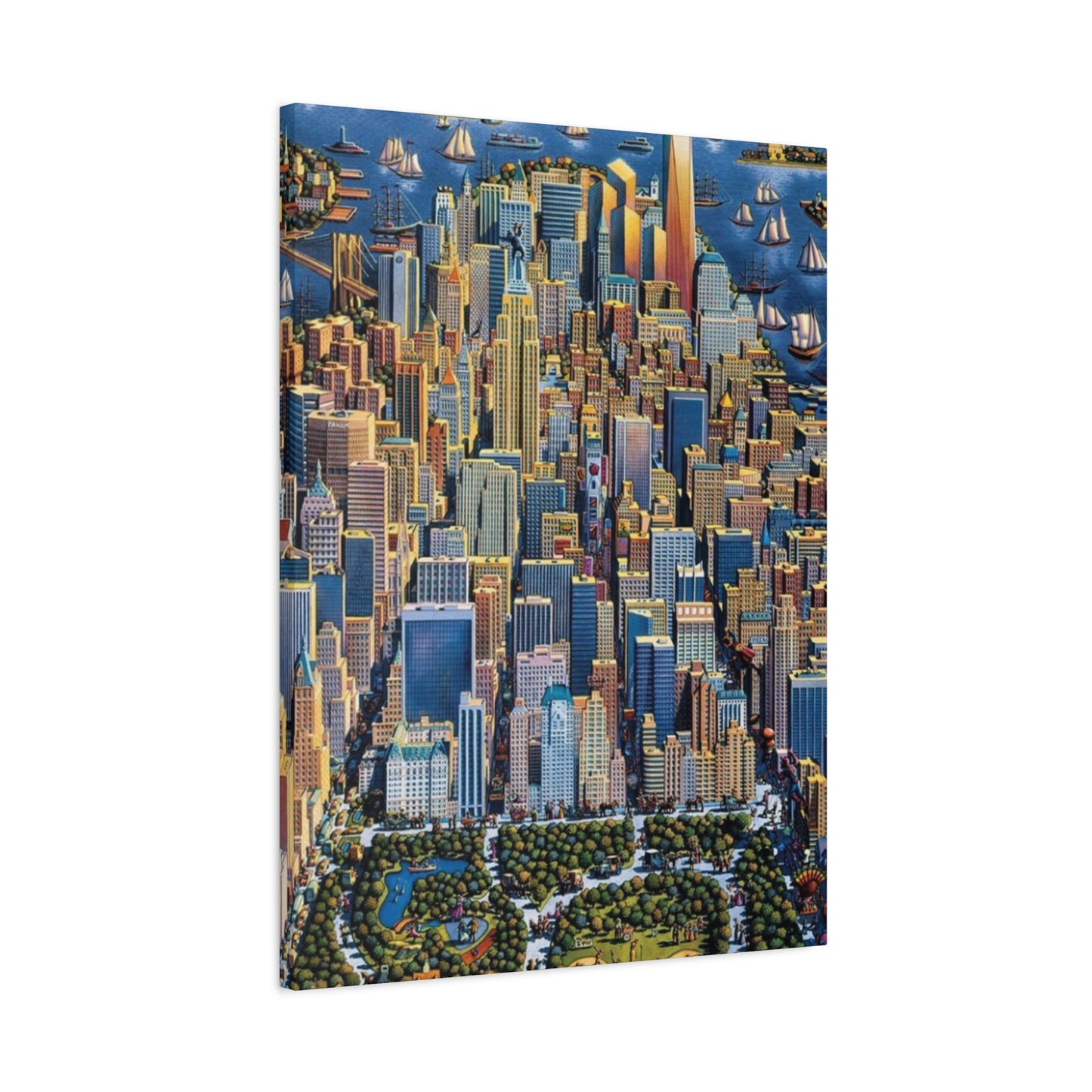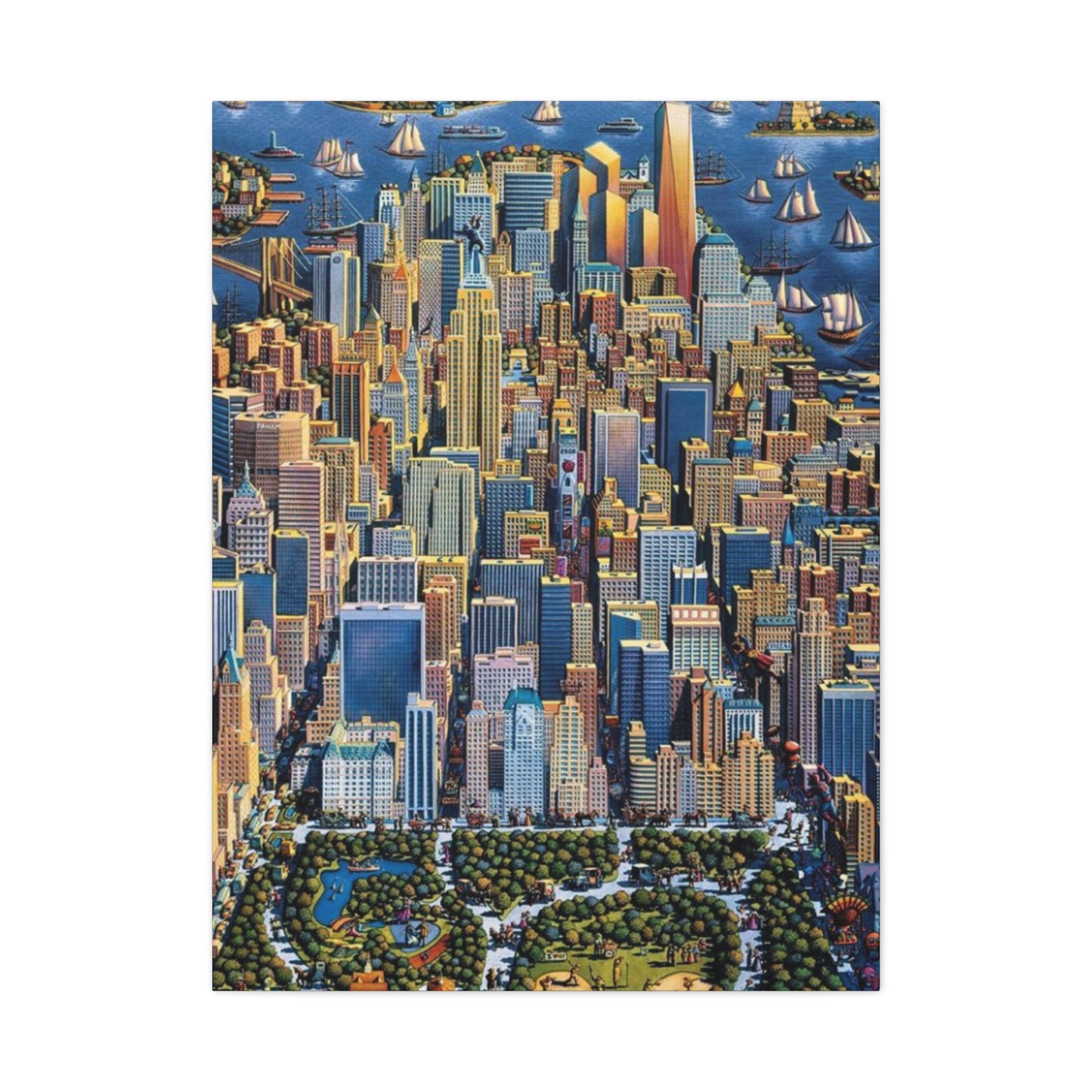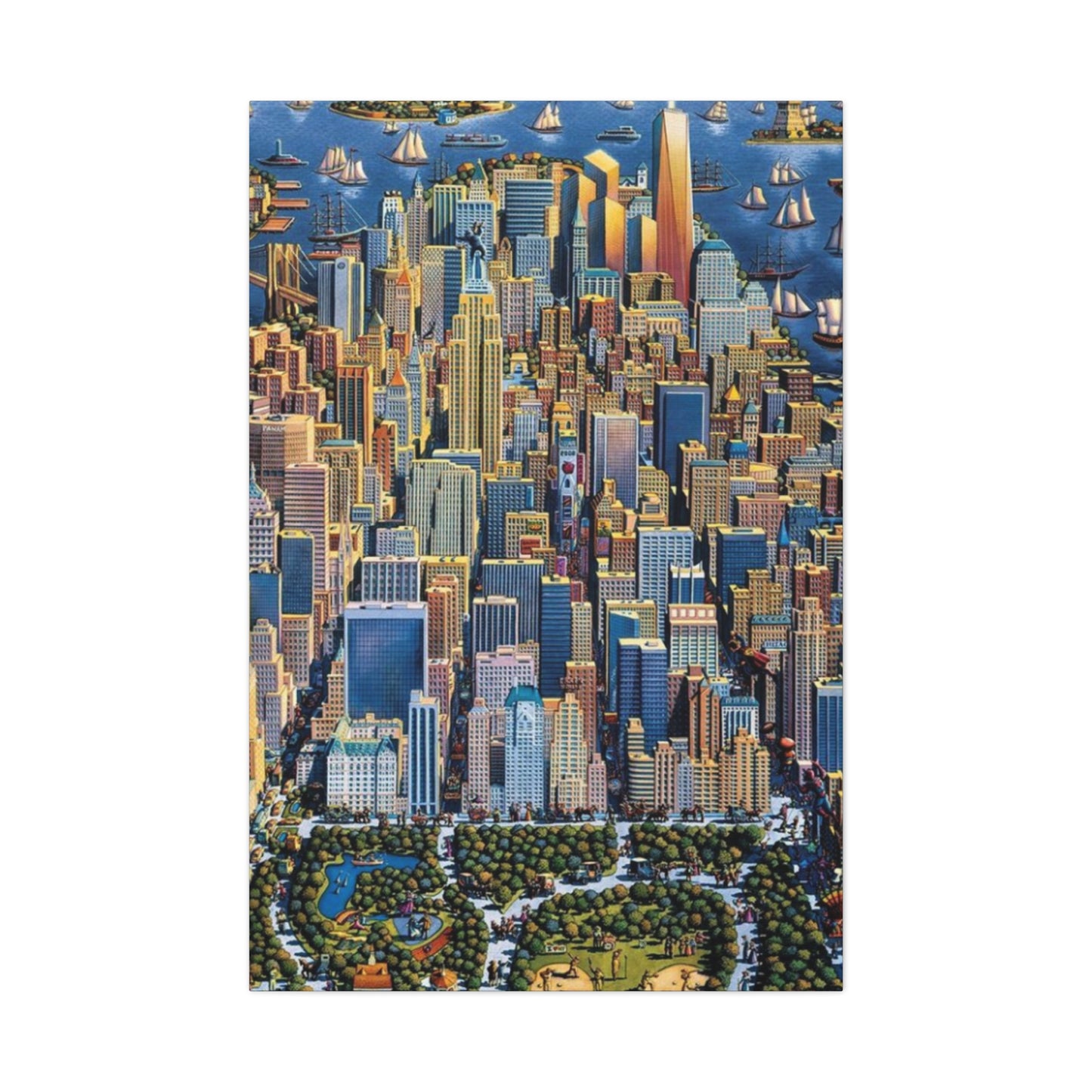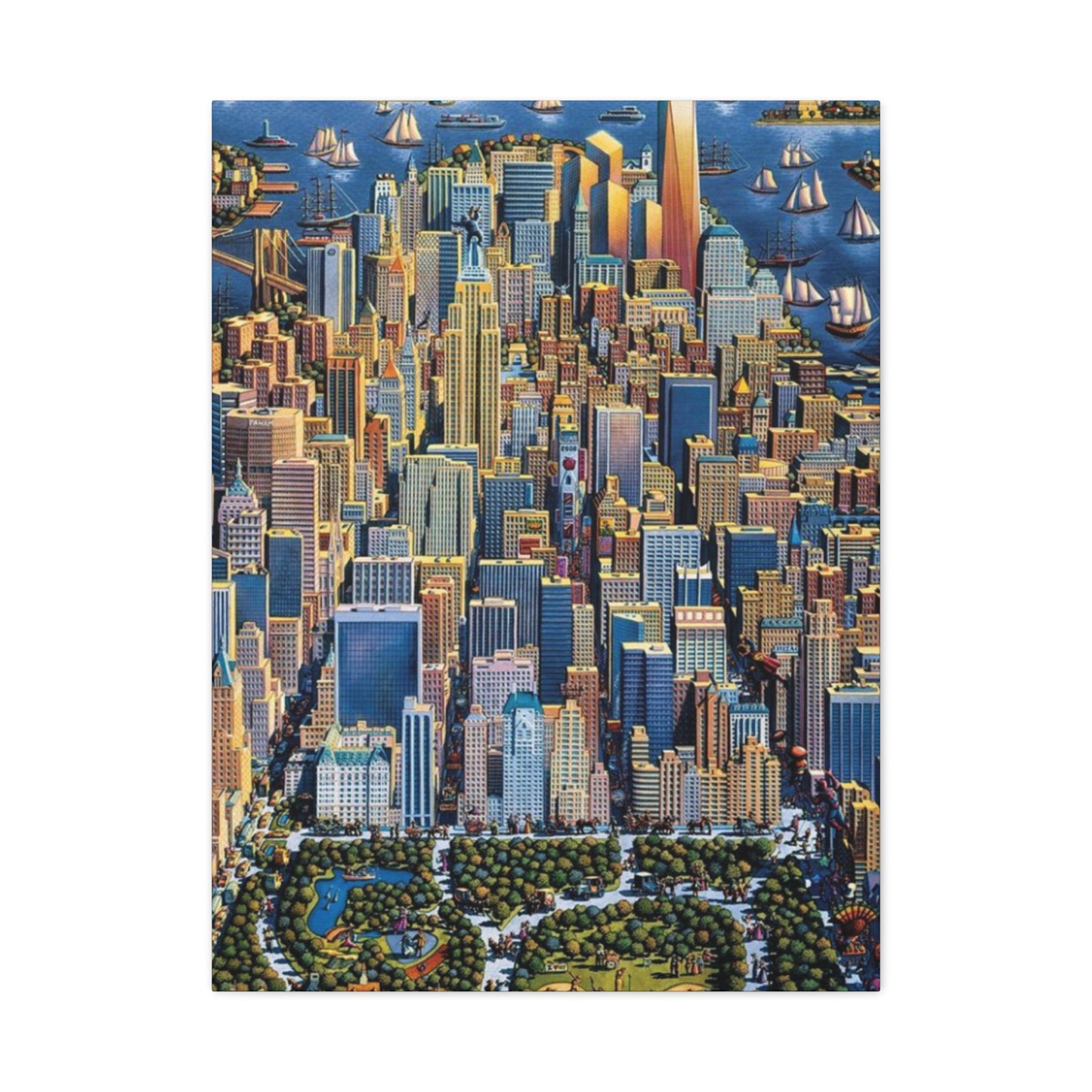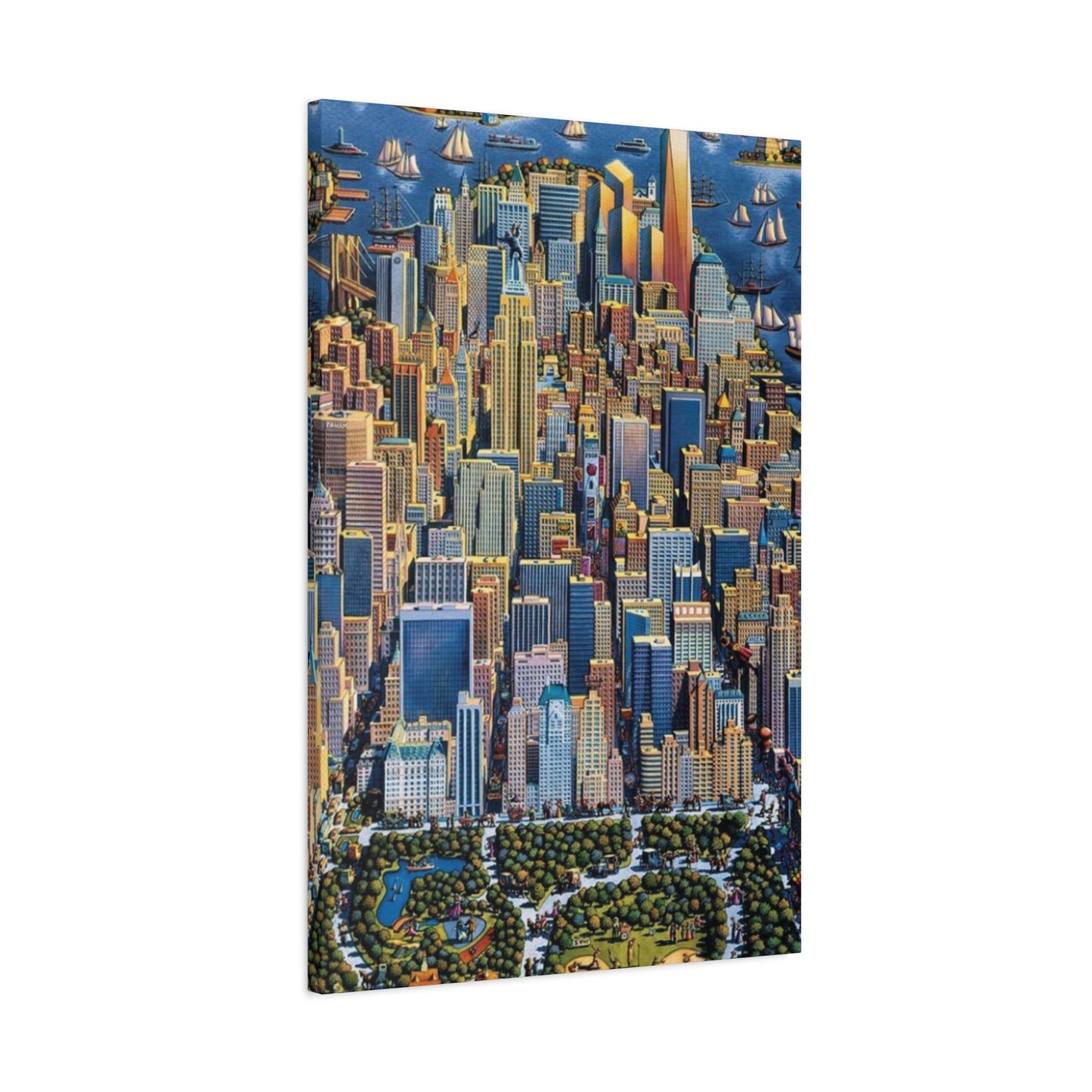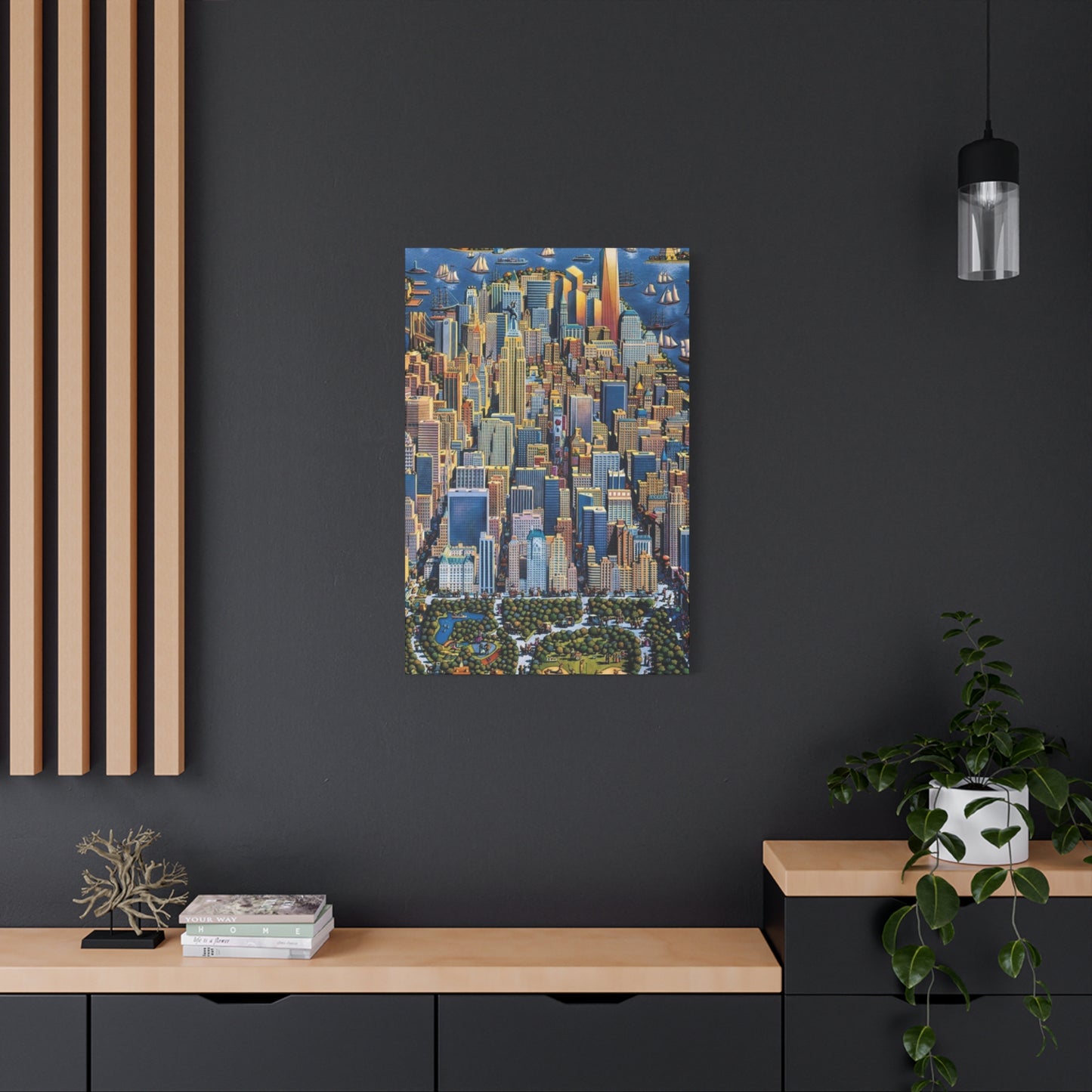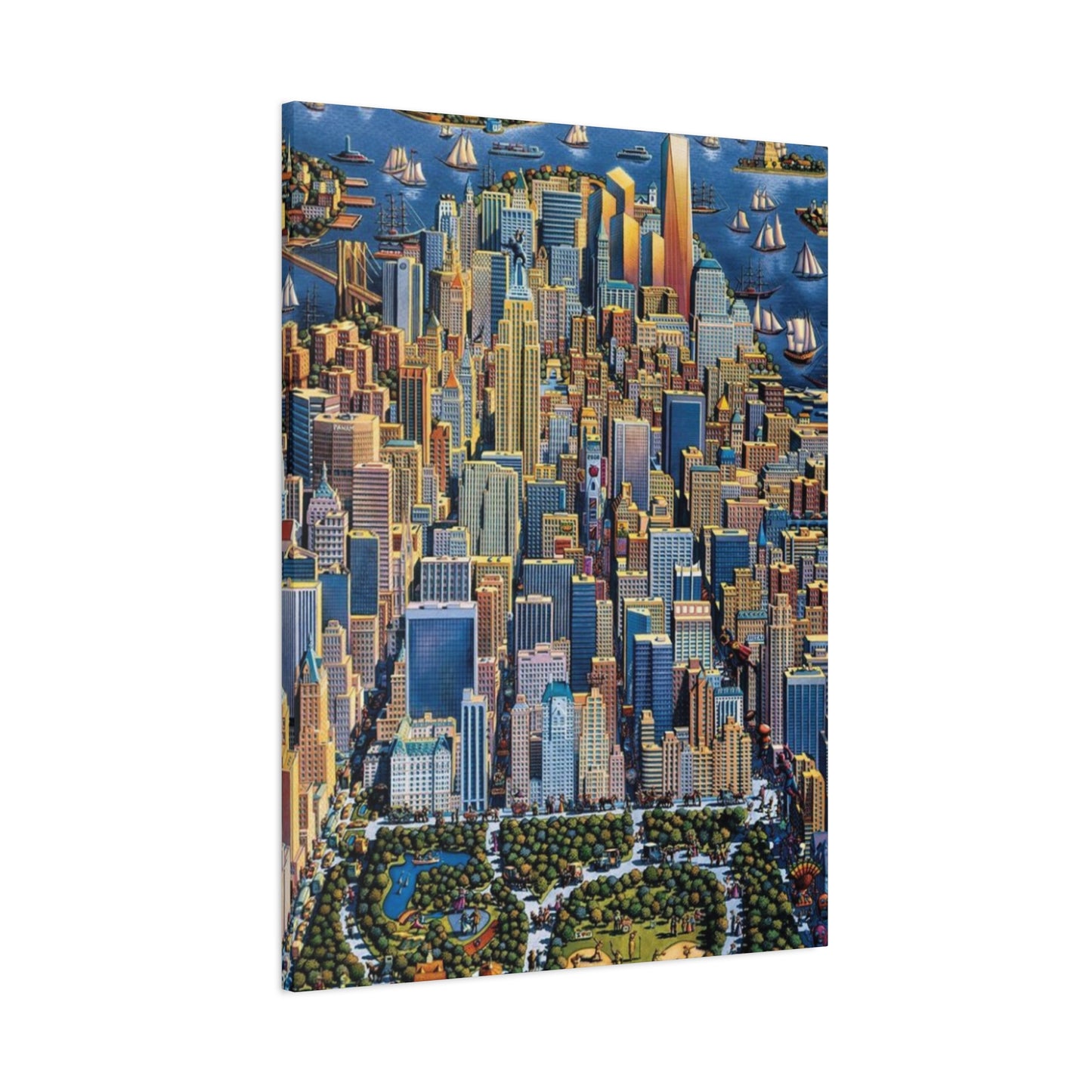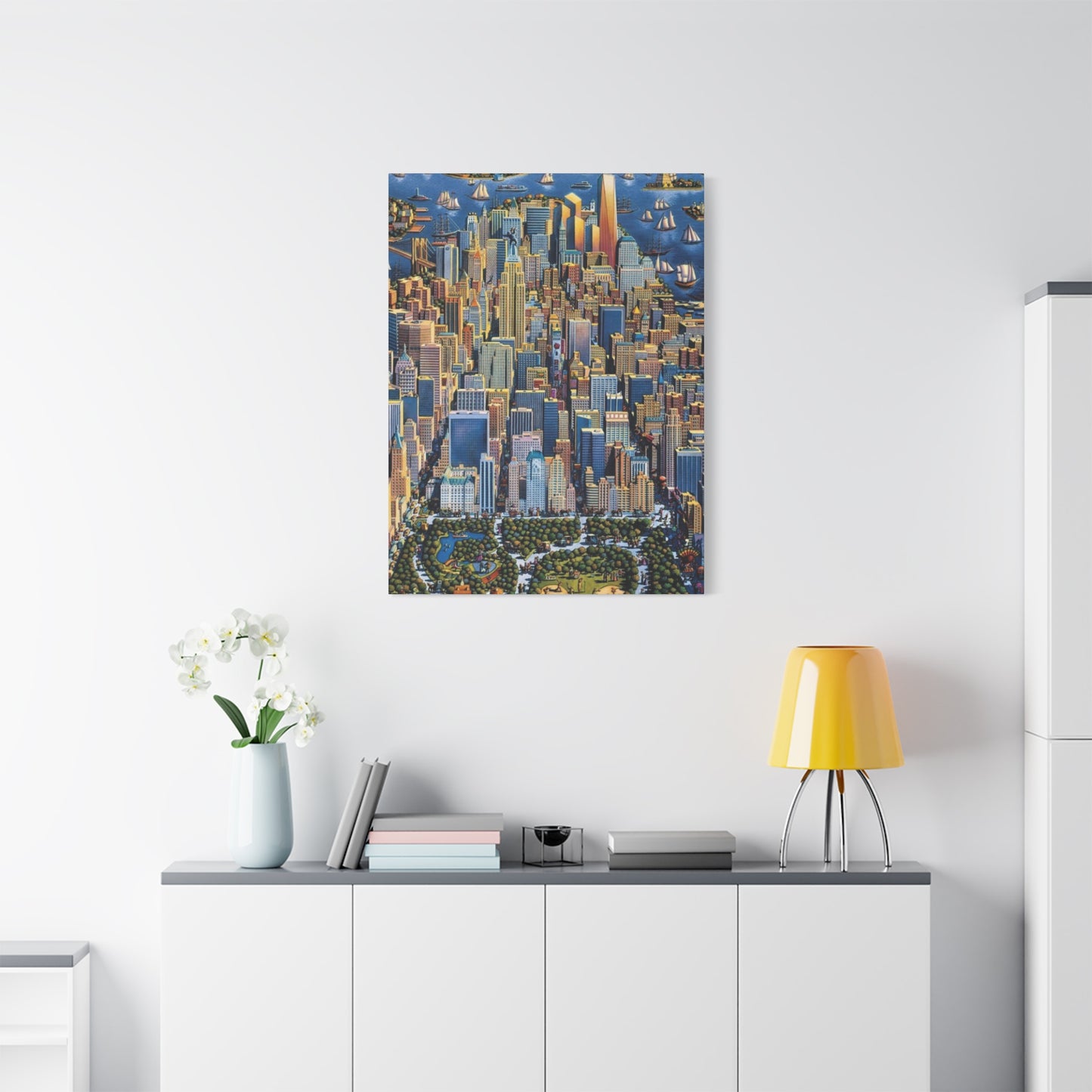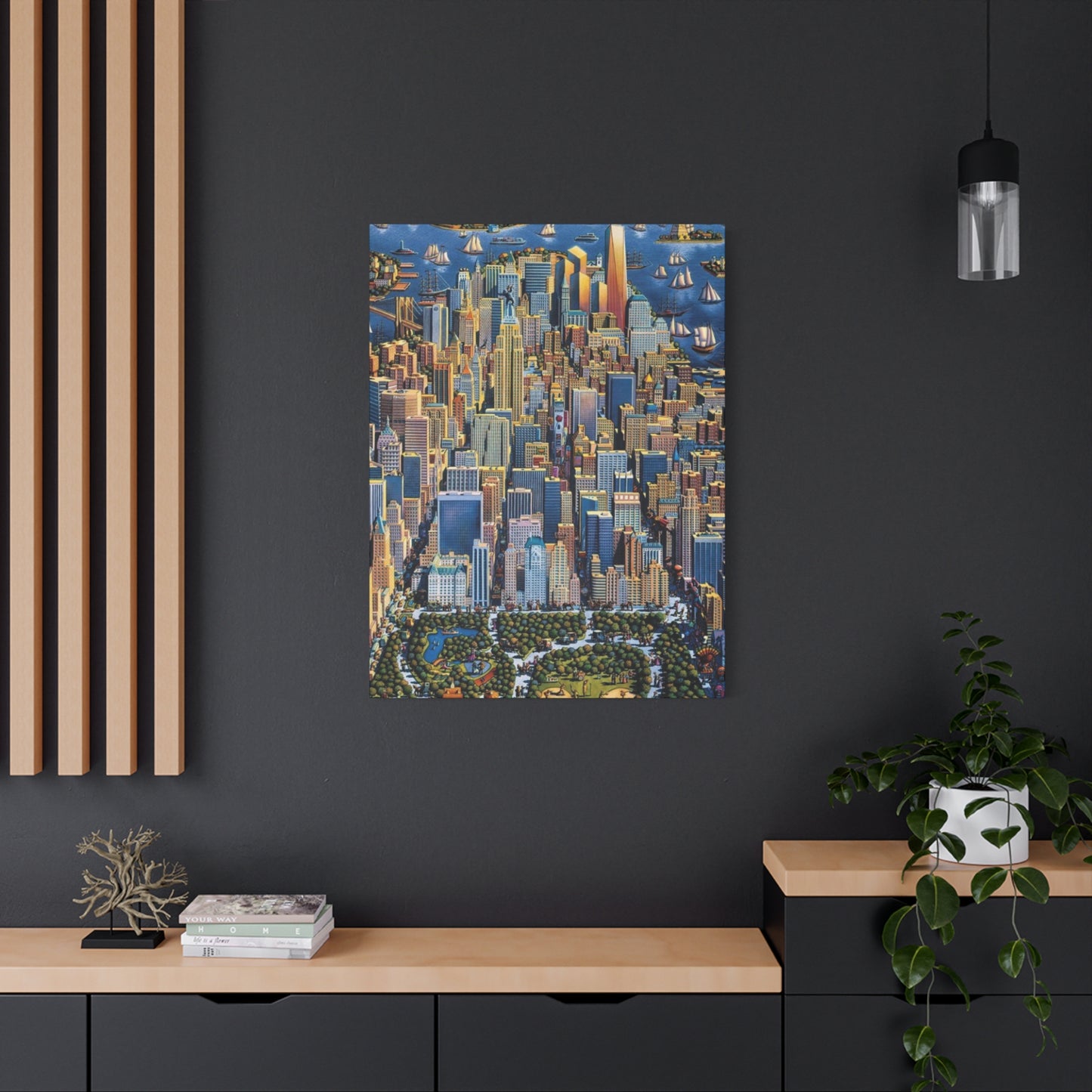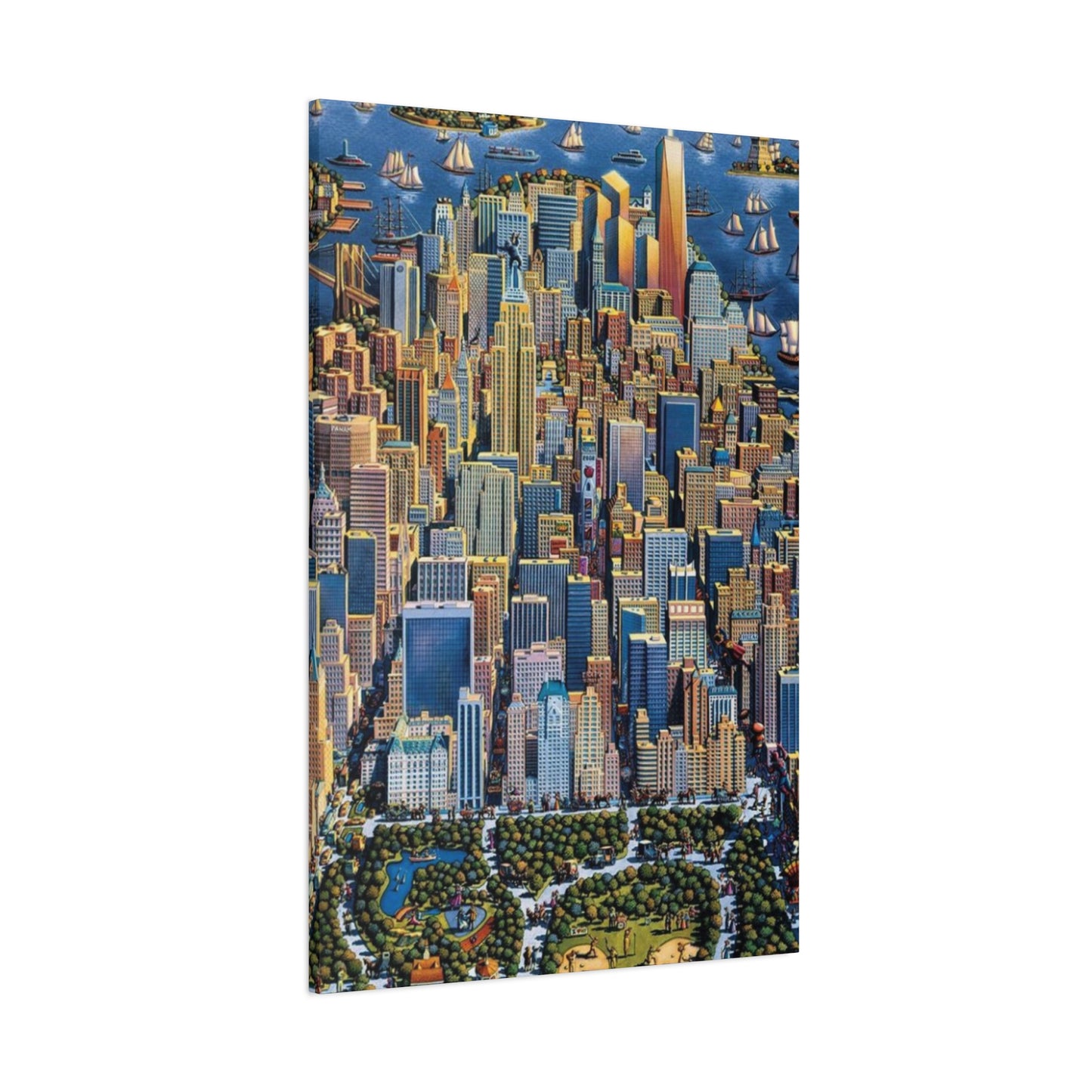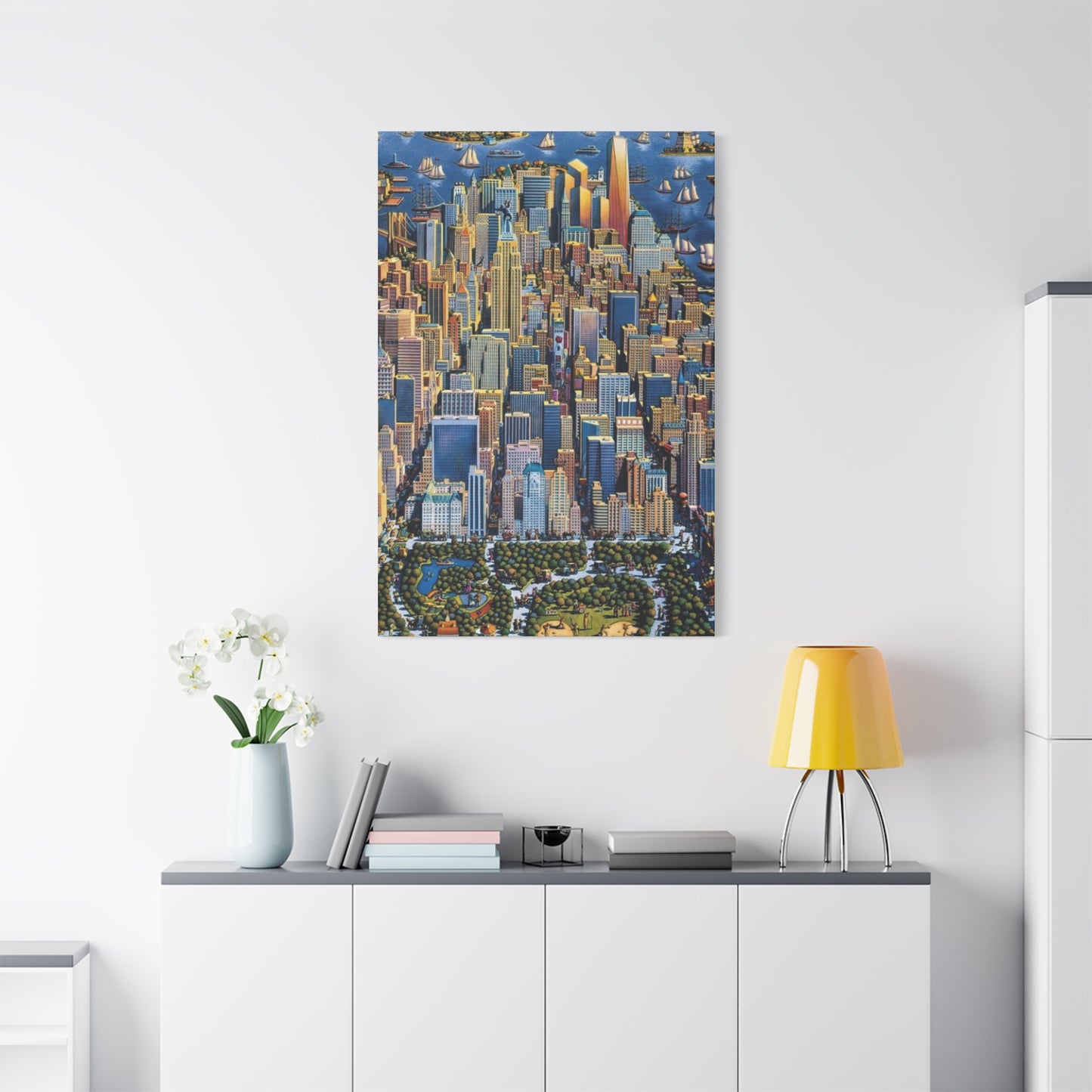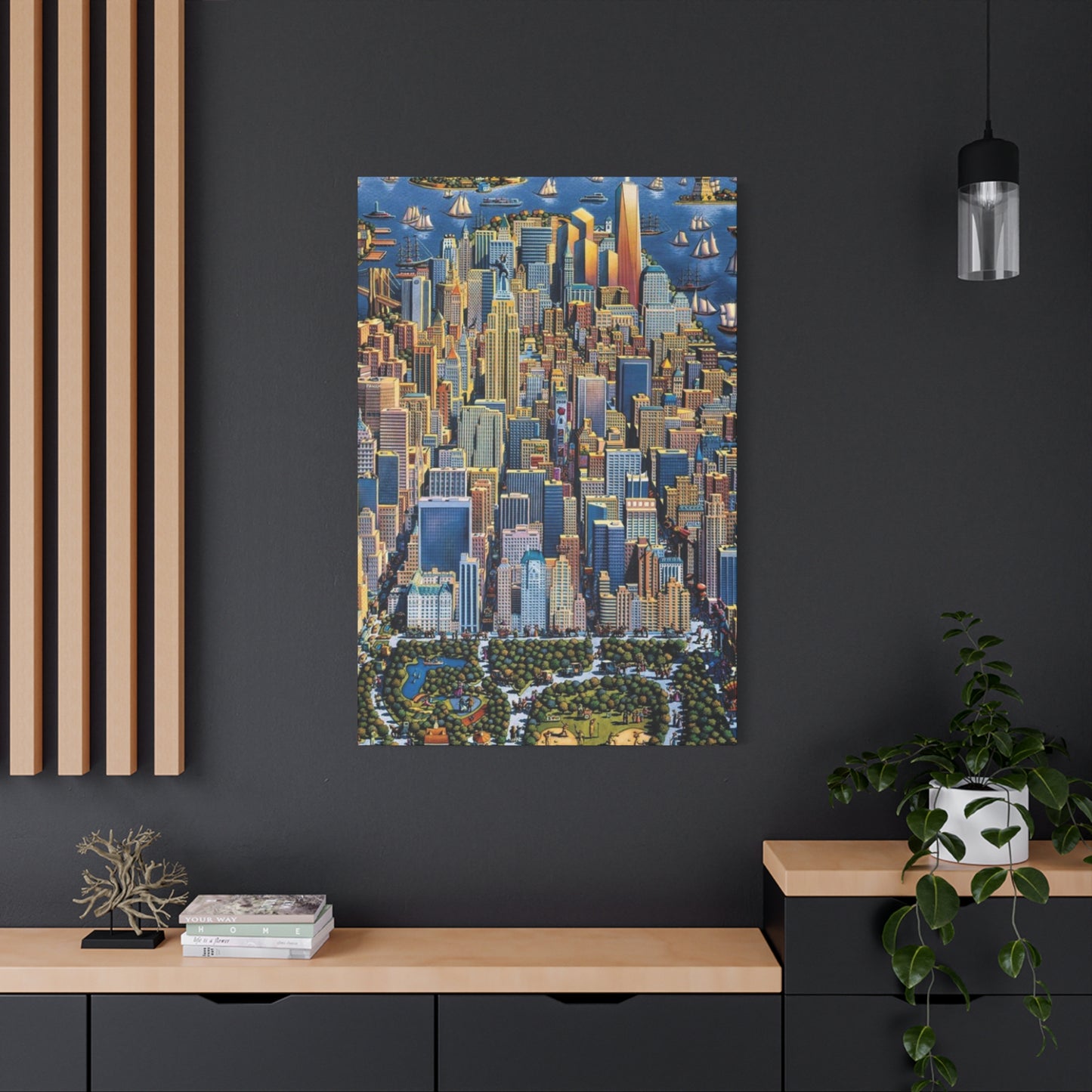Central Park New York City Skyline Wall Art: Bringing the Big Apple's Beauty Into Your Space
New York City has long been recognized as one of the most photographed and artistically represented cities across the globe. The magnificent skyline featuring towering skyscrapers, the lush greenery of Central Park, and the iconic Manhattan landscape creates a visual masterpiece that captures the hearts of millions. When you bring this breathtaking scenery into your living space through wall art, you're not just decorating your walls but creating an emotional connection to one of the world's most vibrant metropolitan areas.
The artistic representation of Manhattan's skyline combined with Central Park offers a unique blend of urban sophistication and natural serenity. This combination makes such artwork incredibly versatile, fitting seamlessly into various interior design styles from modern minimalist to classic traditional. The contrast between the concrete jungle and the verdant park creates a visual harmony that speaks to the duality of city living where nature and architecture coexist in perfect balance.
Wall art featuring the New York City skyline serves multiple purposes beyond mere decoration. It acts as a conversation starter, a statement piece, and a window to one of the world's most exciting cities. Whether you've lived in New York, visited as a tourist, or simply dreamed of experiencing the city's energy, having this artwork in your home creates a constant reminder of the possibilities and adventures that the Big Apple represents.
The popularity of Manhattan skyline artwork has grown exponentially over the years, with artists and photographers capturing the city from countless angles and perspectives. Each piece tells a different story, whether it's the golden hour casting warm hues over the buildings, the twinkling lights of the city at night, or the peaceful morning mist rising over Central Park. This diversity ensures that there's a perfect piece for every taste and preference.
Central Park in Manhattan's Landscape
Central Park stands as a monumental achievement in urban planning and landscape architecture, stretching across 843 acres in the heart of Manhattan. Designed by Frederick Law Olmsted and Calvert Vaux in 1858, this urban oasis revolutionized the concept of public parks in American cities. The park's creation was a visionary response to the rapid urbanization of New York City, providing residents with a natural retreat from the bustling streets and growing industrial landscape.
The historical context of Central Park adds layers of meaning to any artwork depicting this iconic location. The park represented a democratic ideal where people from all social classes could gather and enjoy nature freely. This philosophical foundation continues to resonate today, making Central Park not just a physical space but a symbol of accessibility, community, and the human need for natural beauty even in the midst of urban development.
Throughout its existence, Central Park has witnessed countless historical moments and cultural shifts in New York City. From peaceful protests to concerts, from quiet morning jogs to bustling weekend picnics, the park has served as a backdrop to the lives of millions. This rich history infuses any artistic representation with deeper significance, transforming a simple landscape into a narrative of human experience and urban evolution.
The juxtaposition of Central Park against Manhattan's ever-changing skyline creates a powerful visual metaphor. While skyscrapers rise and fall, constantly reshaping the urban horizon, Central Park remains a constant, a green heart beating steadily amidst the steel and glass. This permanence makes the park an anchor point in skyline artwork, providing balance and perspective to the vertical thrust of the surrounding buildings.
Artists who capture Central Park within the broader Manhattan skyline context are documenting not just a location but a relationship between humanity and nature. The park's carefully designed landscapes, featuring meadows, woodlands, and water bodies, demonstrate how urban spaces can incorporate natural elements without sacrificing metropolitan functionality. This balance has inspired countless artists to explore the theme through various mediums and styles.
Different Artistic Styles for Manhattan Skyline Wall Art
Photography stands as one of the most popular mediums for capturing the Manhattan skyline and Central Park. Professional photographers spend countless hours waiting for the perfect lighting conditions, seasonal changes, and atmospheric phenomena to create stunning images. High-quality photographic prints offer incredible detail, allowing viewers to discover new elements each time they examine the piece. The realism of photography appeals to those who want an authentic representation of the city.
Abstract interpretations of the Manhattan skyline offer a completely different aesthetic experience. Artists working in abstract styles use colors, shapes, and forms to convey the essence and energy of New York City rather than literal representation. These pieces might feature bold geometric shapes representing buildings, swirling patterns suggesting movement and activity, or color fields evoking the emotional atmosphere of the city. Abstract art works particularly well in modern and contemporary interior designs.
Watercolor paintings of the Manhattan skyline bring a softer, more romantic quality to the subject. The medium's inherent fluidity and transparency create dreamlike renditions where colors bleed into each other, buildings seem to emerge from mist, and the boundary between sky and architecture becomes beautifully ambiguous. Watercolor artwork adds a gentle, artistic touch to spaces while still maintaining the recognizable elements of the New York City landscape.
Oil paintings offer rich textures and vibrant colors that bring depth and dimension to Manhattan skyline artwork. Traditional oil painting techniques allow artists to build layers of color and detail, creating pieces with substantial visual weight and presence. The classic nature of oil paintings makes them excellent choices for more formal spaces or for collectors who appreciate traditional artistic methods. The luminosity achievable with oil paints particularly enhances sunset and nighttime skyline scenes.
Digital art and mixed media approaches have opened exciting new possibilities for representing the Manhattan skyline. Artists combine photography with painting, incorporate textural elements, or use digital manipulation to create unique interpretations. These contemporary approaches appeal to those looking for something distinctive and innovative. Mixed media pieces can include elements like newspaper clippings, fabric, or metallic accents that add physical dimension to the artwork.
Minimalist line drawings and sketches offer an elegant, understated approach to skyline artwork. Using simple black lines on white backgrounds or subtle monochromatic palettes, these pieces capture the essential silhouette and character of Manhattan without overwhelming detail. Minimalist artwork works exceptionally well in spaces where clean lines and simplicity are prioritized, providing visual interest without competing with other design elements.
Pop art interpretations bring energy and vibrancy to Manhattan skyline representations. Drawing inspiration from artists like Andy Warhol and Roy Lichtenstein, pop art versions might feature bold colors, repeated patterns, or graphic elements that celebrate the commercial and cultural aspects of New York City. These playful pieces work wonderfully in eclectic spaces, entertainment rooms, or anywhere a burst of personality is desired.
Seasonal Variations in Central Park Skyline Artwork
Spring in Central Park brings an explosion of new life that transforms the entire landscape and consequently the artistic representations of this space. Cherry blossoms create clouds of pink and white throughout the park, while fresh green leaves emerge on trees that stood bare throughout winter. Artists capturing spring scenes often emphasize renewal, growth, and the soft pastel colors that dominate this season. The contrast between the delicate natural beauty and the solid permanence of Manhattan's skyscrapers becomes particularly striking during spring.
The energy of spring extends beyond just visual elements. There's a palpable excitement as New Yorkers emerge from winter hibernation to enjoy the park's paths, meadows, and recreational areas. Artwork depicting spring scenes often captures people engaged in outdoor activities, adding human elements that emphasize the park as a living, breathing community space. The longer daylight hours of spring also provide artists with extended golden hour periods when warm light bathes both the park and surrounding buildings in amber hues.
Summer transforms Central Park into a lush, verdant paradise where the full canopy of trees creates a green roof over much of the park. Summer skyline artwork often features deep, rich greens and the brilliant blue skies typical of the season. The vibrancy of summer colors creates bold, energetic compositions that bring warmth and vitality to interior spaces. Artists might capture the park's famous Great Lawn crowded with sunbathers, the sailboats on the lake, or families enjoying picnics beneath towering oak trees.
The quality of light during summer months differs significantly from other seasons, with bright, intense sunshine creating strong shadows and highlights. This dramatic lighting adds depth and dimension to skyline photographs and paintings. Evening summer scenes are particularly magical, with extended twilight periods painting the sky in gradients of orange, pink, and purple while the city lights begin to twinkle on. These transitional moments between day and night offer artists rich opportunities for creating atmospheric pieces.
Autumn brings perhaps the most visually spectacular transformation to Central Park as foliage changes to brilliant reds, oranges, and golds. Fall skyline artwork bursts with warm colors that create cozy, inviting feelings perfect for residential spaces. The contrast between the fiery autumn trees and the neutral tones of Manhattan's buildings creates striking compositions. Many consider autumn the most photogenic season in Central Park, resulting in abundant artwork options featuring this period.
The atmospheric conditions of autumn contribute significantly to the aesthetic appeal of skyline art. Crisp, clear air provides excellent visibility, allowing distant buildings to appear sharp and detailed. Morning mists often rise from the park's water bodies, creating ethereal scenes where skyscrapers emerge from clouds of vapor. The lower angle of autumn sunlight creates longer shadows and warmer color temperatures, enhancing the golden quality that photographers and painters seek.
Iconic Viewpoints for Manhattan Skyline Art
Belvedere Castle offers one of the most elevated perspectives within Central Park itself, providing panoramic views that encompass both the park's natural features and the surrounding skyline. Located on Vista Rock, the castle's vantage point allows photographers and artists to capture the layers of landscape that make Central Park unique. The view includes the Great Lawn, Turtle Pond, and the Ramble, with Manhattan's iconic buildings rising beyond. Artwork from this perspective emphasizes the scale relationship between the park and the city.
The compositional opportunities from Belvedere Castle are exceptional. Artists can frame shots to include the castle's architectural details in the foreground, creating depth and context. The elevation provides clear sight lines to famous buildings like the San Remo, the Beresford, and numerous other Central Park West landmarks. Seasonal changes are particularly visible from this height, allowing for dramatic comparisons between different times of year.
Bow Bridge represents one of Central Park's most romantic and photographed locations, and for good reason. This beautiful cast-iron bridge spans the Lake, offering views toward both the Ramble and the West Side skyline. The bridge's elegant curve creates natural framing opportunities for skyline compositions. Artists often capture the reflection of buildings and sky in the calm water beneath the bridge, doubling the visual impact. The combination of Victorian-era architecture and modern skyscrapers creates interesting temporal juxtapositions.
Photography from Bow Bridge works particularly well during golden hour when warm light illuminates both the bridge's details and the distant buildings. The bridge's dark ironwork creates strong lines that guide the viewer's eye through the composition toward the skyline. Many couples choose this location for portraits, and including human figures on the bridge adds scale and emotional resonance to skyline artwork. The seasonal foliage surrounding the bridge provides varying color palettes throughout the year.
The Jacqueline Kennedy Onassis Reservoir offers unobstructed views of the Manhattan skyline reflected in its calm waters. The running track that circles the reservoir provides numerous angles for capturing skyline views, each with slightly different building arrangements and compositions. The water's reflection creates mirror images that double the visual interest, particularly on still days when the surface becomes glassy. This location is especially popular for sunrise and sunset photography when colorful skies are reflected in the water.
Artists working from the Reservoir viewpoint can create minimalist compositions that emphasize horizontal lines and symmetry. The open water provides negative space that balances the density of the skyline. During different seasons, the Reservoir takes on various characters from frozen solidity in winter to sparkling blue in summer, each offering unique artistic possibilities. The changing light throughout the day dramatically alters the mood and color palette available from this location.
Sheep Meadow provides a ground-level perspective that emphasizes the expanse of open green space with the skyline rising majestically in the background. This 15-acre lawn becomes a gathering place during warm months, and artwork from this location often includes people relaxing, playing, or picnicking, adding life and scale to compositions. The relatively flat topography allows the skyline to dominate the horizon, creating powerful images of urban nature.
The wide-open quality of Sheep Meadow gives artists room to work with expansive sky compositions. Cloud formations, sunset colors, and atmospheric conditions become significant elements in artwork from this perspective. The meadow's changing conditions throughout seasons, from lush green grass to golden autumn tones to snow-covered winter expanses, provide varied moods while maintaining the same basic compositional structure. This location excels for capturing the human experience of Central Park within the larger urban context.
Gapstow Bridge, located near the park's southeast corner, offers intimate views that include the Pond, surrounding vegetation, and the Plaza Hotel and other Fifth Avenue buildings in the background. This location provides a more enclosed, romantic perspective compared to the open vistas elsewhere in the park. The stone bridge itself adds rustic character to compositions, creating contrast with the sleek modern buildings beyond. The Pond's surface provides reflection opportunities, particularly beautiful during autumn when surrounding trees display fall colors.
Size and Scale Considerations for Wall Art
Large-scale wall art makes bold statements and serves as focal points in rooms. Pieces measuring five feet or wider can anchor entire walls, particularly in spacious areas like living rooms, offices, or lobbies. Manhattan skyline artwork in large formats allows viewers to experience the expansiveness of the city and park. The immersive quality of large pieces creates the feeling of looking through a window onto the actual landscape. These substantial works demand attention and shape the entire aesthetic of a space.
Selecting large-scale artwork requires careful consideration of viewing distance. In spaces where people will be relatively close to the wall, extremely large pieces might overwhelm. However, in rooms with ample space for stepping back, larger artwork can be appreciated in full. The detail level in the chosen piece should match the size; highly detailed photographs and paintings reward close examination in large formats, while more impressionistic or abstract pieces may work better when impact comes from overall composition rather than fine details.
Medium-sized pieces, typically ranging from two to four feet in width, offer versatility for various spaces. These dimensions work well above furniture like sofas, beds, or consoles where they can anchor an area without overwhelming it. Medium-sized Manhattan skyline art fits comfortably in most residential and commercial settings. The scale is approachable, allowing the artwork to enhance rather than dominate a room. Multiple medium-sized pieces can be combined in gallery wall arrangements for greater impact.
The beauty of medium-sized artwork lies in its adaptability. Such pieces can serve as primary focal points in smaller rooms or as supporting elements in larger spaces. They're substantial enough to make aesthetic statements while remaining practical for most wall dimensions. For renters or those who move frequently, medium-sized pieces are easier to transport and rehang in new spaces. The investment level is also more accessible while still providing significant visual impact.
Small-scale artwork, typically under two feet in any dimension, works beautifully in intimate spaces, as part of gallery walls, or in areas where wall space is limited. Smaller Manhattan skyline pieces can be positioned on shelves, desks, or narrow wall sections. Despite their compact size, quality small-scale artwork delivers concentrated visual interest. Detailed prints and paintings remain engaging at smaller sizes, particularly when viewed up close. Collections of small pieces can be arranged to create larger compositional statements.
Small artwork offers flexibility for those who enjoy frequently changing their decor or rotating pieces seasonally. The lower cost point of smaller pieces allows for collecting multiple works depicting different views, seasons, or artistic styles. Gallery walls combining various small-scale Manhattan skyline pieces can tell a broader story about the city and park. The intimacy of small artwork makes it appropriate for personal spaces like bedrooms, home offices, or reading nooks where close viewing occurs.
Panoramic formats, whether large or moderate in size, naturally suit Manhattan skyline subjects. The horizontal orientation mimics the experience of scanning across the landscape, creating dynamic compositions. Panoramic pieces work exceptionally well above long furniture pieces, in hallways, or anywhere horizontal emphasis is desired. The format inherently conveys expansiveness and can make rooms feel larger. Many iconic skyline views are best captured in panoramic ratios that accommodate the full sweep of architecture and landscape.
Color Palettes and Their Emotional Impact
Black and white photography and artwork bring timeless elegance to Manhattan skyline representations. The absence of color focuses attention on composition, light, shadow, and form. Monochromatic pieces highlight the architectural geometry of buildings and the organic patterns of Central Park's landscape. Black and white art creates sophisticated, neutral statements that work with virtually any interior color scheme. The dramatic contrast possible in monochrome work adds visual punch without introducing competing colors into a designed space.
The emotional quality of black and white skyline art tends toward contemplation and nostalgia. These pieces often evoke classic photography from New York's past, connecting present-day scenes with the city's rich history. The lack of color can emphasize mood and atmosphere; foggy, rainy, or snowy conditions become more dramatic in monochrome. Black and white artwork suits both modern minimalist spaces and more traditional environments, demonstrating remarkable versatility across design styles.
Warm color palettes featuring golds, oranges, reds, and yellows create inviting, energetic artwork that brings warmth to interiors. Sunset and sunrise views of Manhattan naturally incorporate these hues as light interacts with sky, buildings, and landscape. Warm-toned skyline art works particularly well in spaces where cozy, welcoming atmospheres are desired. The psychological impact of warm colors includes feelings of comfort, optimism, and vitality, making these pieces appropriate for living areas, dining spaces, and social zones.
Autumn scenes from Central Park naturally lean into warm palettes with their brilliant foliage. Artists emphasizing warm tones might saturate these colors further, creating bold, dramatic statements. Warm lighting conditions like golden hour bathe entire scenes in amber hues that unify all elements. The combination of warm natural tones from the park with the typically neutral colors of buildings creates harmonious compositions. Warm-toned artwork can visually warm up rooms with cool natural light or cooler design palettes.
Cool color palettes dominated by blues, greens, and purples create calm, serene artwork that promotes relaxation. Twilight and nighttime views of Manhattan often feature deep blues and purples in the sky with cooler-toned lighting from buildings. Cool-palette artwork works well in bedrooms, bathrooms, or any space designed for tranquility. The psychological impact of cool colors includes feelings of peace, spaciousness, and clarity, making these pieces conducive to focused work or restful environments.
Material and Printing Considerations
Canvas prints represent one of the most popular mediums for Manhattan skyline wall art. The textile surface of canvas provides texture that adds depth and an artistic quality to images. Canvas naturally suits both photographs and painted works, offering versatility across artistic styles. The material's flexibility allows for gallery-wrap mounting where the image continues around the frame edges, creating a finished look without requiring additional framing. Canvas prints work particularly well with colorful, painterly images where the texture enhances rather than detracts from the artwork.
The durability of canvas makes it appropriate for high-traffic areas and commercial spaces. Quality canvas prints resist fading when treated with protective coatings and can last for decades with proper care. The matte surface minimizes glare, allowing artwork to be viewed from various angles without reflection issues. Canvas pieces maintain a lighter weight than glass-covered alternatives, simplifying hanging and reducing wall stress. The casual elegance of canvas suits contemporary and transitional interior styles particularly well.
Metal prints offer a sleek, modern presentation that makes colors appear vibrant and luminous. The process of infusing dyes directly into specially coated aluminum creates images with exceptional clarity and depth. Metal prints work magnificently with nighttime Manhattan skyline scenes where city lights and reflections benefit from the material's inherent luminosity. The surface can be glossy for maximum vibrancy or matte for reduced reflections. Metal prints resist fading, moisture, and scratching, making them incredibly durable.
The contemporary aesthetic of metal prints suits modern, industrial, and minimalist interiors. The material's slim profile and lack of required framing create clean, uncluttered presentations. Metal prints can be mounted directly to walls using floating hardware, creating the illusion that the image hovers off the wall surface. The lightweight nature of aluminum makes installation straightforward even for large pieces. Collectors who appreciate cutting-edge presentation methods and maximum image quality often choose metal prints.
Acrylic prints, also called face-mounted or plexiglass prints, provide stunning depth and a gallery-quality presentation. The process involves mounting photographs to rigid backing and covering them with clear acrylic, creating a glossy surface that makes images appear three-dimensional. Acrylic prints work exceptionally well with high-resolution Manhattan skyline photography where fine details deserve showcase. The material adds richness to colors and creates a jewel-like quality that captures attention.
The luxurious appearance of acrylic prints suits upscale residential and commercial spaces. The substantial thickness and weight of acrylic create impressive physical presence. The glossy surface does produce reflections that require consideration regarding placement and lighting. Acrylic prints clean easily and resist environmental damage, maintaining their appearance for years. The premium nature of acrylic makes these pieces investment-quality art appropriate for serious collectors and design-focused spaces.
Framed prints under glass offer traditional presentation that suits various artistic styles from photography to watercolors to prints. The protective glass shield preserves the artwork from environmental factors like dust, moisture, and UV light. Museum-quality framing with archival matting ensures longevity and proper preservation. The frame itself becomes part of the artistic statement, with options ranging from simple modern frames to ornate traditional styles. Framed pieces work in virtually any setting from traditional to contemporary.
Placement Strategies for Maximum Impact
Living rooms serve as primary gathering spaces where Manhattan skyline wall art can make significant impact. Large statement pieces work beautifully above sofas where they anchor the seating area and provide a focal point. The artwork should be positioned at eye level when seated, typically placing the center of the piece about 60 inches from the floor or slightly lower if the sofa is particularly low. The width of the artwork should relate to the furniture below it, generally spanning between half to three-quarters of the sofa's width.
Consider the viewing distances in your living room when selecting artwork size and detail level. In spacious living rooms where people will view the art from across the room, larger pieces with bold compositions work best. In more intimate spaces, medium-sized pieces with finer details can be appreciated from closer viewing distances. The artwork should complement the overall color scheme without exactly matching it; introducing new colors through the art adds visual interest and depth to the room's design.
Bedrooms benefit from calming Manhattan skyline artwork that promotes relaxation. Pieces positioned above the headboard create a focal point while remaining visible when reclining in bed. The scale should be appropriate to the bed size; king-sized beds accommodate larger artwork while full or queen beds work better with medium-sized pieces. Consider subject matter carefully for bedroom artwork, favoring peaceful scenes like serene park views, soft sunset colors, or tranquil morning mists over energetic cityscape compositions.
The color palette of bedroom skyline art should coordinate with the room's overall design while supporting a restful atmosphere. Cool tones or muted palettes often work better than vibrant, energizing colors in sleep spaces. Artwork placement should avoid positions where it might cause distraction when trying to sleep. Some people prefer no art directly across from the bed where it draws the eye, while others enjoy having a pleasant view from their pillows. Personal preference guides these decisions along with overall bedroom layout and design.
Home offices and study spaces benefit from inspiring Manhattan skyline artwork that energizes without distracting. Position artwork where it's visible from the desk but doesn't compete with computer screens or task lighting. Artwork placed behind the seating area creates an impressive background for video calls while providing visual interest for the room's occupant when turning from the desk. The subject matter can be more energetic in offices than bedrooms, with vibrant cityscapes and dynamic compositions helping maintain focus and motivation.
Consider the psychological impact of artwork in workspaces. Inspiring views of Manhattan's ambition and Central Park's tranquility can reinforce positive attitudes toward productivity and success. The artwork scale should be appropriate to the room size and wall space available. Home offices in small spaces might accommodate one well-chosen piece, while larger dedicated office rooms can handle substantial statement art or gallery wall arrangements. The professional appearance of office artwork matters if clients or colleagues visit or appear on video calls.
Dining rooms and kitchens offer opportunities for Manhattan skyline art that enhances the social nature of these spaces. Artwork in dining areas is typically viewed from seated positions during meals, suggesting placement at slightly lower heights than in other rooms. The subject matter can be more adventurous in dining spaces since these rooms are designed for stimulation and conversation rather than relaxation. Vibrant colors and energetic compositions work well, potentially stimulating appetite and conversation.
Kitchen artwork must consider environmental factors like humidity, heat, and cooking splatter. Position skyline art away from stoves and sinks where exposure to these elements could damage the piece. Sealed, wipeable surfaces like metal or acrylic prints work particularly well in kitchens. Consider the viewing patterns in kitchens where people move frequently and view spaces from various angles. Multiple smaller pieces might work better than one large statement piece in active kitchen spaces, allowing the eye to engage with art throughout the room.
Caring for Your Manhattan Skyline Wall Art
Regular dusting prevents dirt accumulation that can damage artwork over time. Use soft, clean microfiber cloths or specialized art dusting tools that gently remove surface dust without scratching. Dust weekly or biweekly depending on environmental conditions and air quality. Avoid feather dusters that can snag on frame details or canvas texture. Never apply cleaning solutions directly to artwork surfaces. Light, gentle motions prevent accidental damage while effectively removing dust. Paying attention to frame edges, top surfaces, and corners ensures thorough cleaning.
The dusting technique varies slightly depending on artwork type. For framed pieces under glass, dust the glass surface and frame with gentle circular motions. Canvas prints should be dusted even more gently, following the weave direction when possible to avoid catching fibers. Metal and acrylic prints tolerate slightly more pressure but still require gentle handling. Dust frames carefully around decorative details where dirt accumulates. Regular dusting maintains the artwork's appearance and prevents buildup that becomes harder to remove over time. This simple maintenance significantly extends the life and beauty of Manhattan skyline wall art.
Deep cleaning of framed artwork under glass requires careful technique to avoid streaking and damage. Use glass cleaner sprayed onto a clean cloth rather than directly on the glass to prevent solution seeping behind the glazing. Wipe in consistent directions rather than circular motions to minimize streaking. Avoid cleaners containing ammonia if the frame has any gilding or decorative finishes that might be damaged. Clean the frame separately using appropriate cleaners for the frame material. Wood frames may need furniture polish or wood cleaner while metal frames can be wiped with damp cloths.
Canvas prints require more delicate cleaning approaches. Never use liquid cleaners directly on canvas as moisture can damage the material and cause colors to run. For stubborn dirt on canvas, slightly damp cloths can be used sparingly, immediately followed by dry cloth blotting. Some specialty canvas cleaning products exist but test on inconspicuous areas first. Professional cleaning may be necessary for valuable canvas pieces with significant soiling. Preventive care through regular dusting remains the best approach for canvas artwork, minimizing the need for more invasive cleaning methods.
Environmental control protects artwork from conditions that cause deterioration. Maintain stable temperature and humidity levels to prevent damage. Ideal conditions involve temperatures between 65-75 degrees Fahrenheit and relative humidity between 40-50 percent. Extreme fluctuations cause materials to expand and contract, leading to warping, cracking, or delamination. Avoid hanging Manhattan skyline artwork in bathrooms, kitchens, or other high-humidity areas unless using moisture-resistant materials like metal or acrylic prints. Climate-controlled environments significantly extend artwork lifespan.
Protection from direct sunlight prevents fading and material degradation. UV radiation causes the most damage to artwork over time. Even north-facing windows provide UV exposure that accumulates. UV-filtering glazing on framed pieces provides protection while maintaining clarity. Window films or treatments can filter UV throughout rooms. If artwork must be positioned near windows, monitor for any signs of fading and be prepared to reposition pieces if problems develop. Artificial lighting should use LED bulbs that produce minimal UV radiation compared to older incandescent or fluorescent bulbs.
Combining Multiple Pieces in Gallery Walls
Gallery wall planning requires careful consideration of piece selection, arrangement, and overall composition. Successful gallery walls tell cohesive stories through related imagery, styles, or themes. For Manhattan skyline gallery walls, consider combining different viewpoints, seasons, or times of day that together provide comprehensive views of Central Park and the cityscape. Mixing artistic styles can work if pieces share complementary colors or similar framing. The goal involves creating unified presentations that feel intentional rather than random collections.
Begin gallery wall planning by laying pieces on the floor to experiment with arrangements before making wall commitments. Photograph various configurations to compare options. Consider the negative space between pieces as carefully as the artwork itself; consistent spacing creates order while varied spacing can add visual interest if done intentionally. The overall shape of the gallery wall matters; rectangular arrangements suit traditional spaces while more organic, asymmetrical layouts work in contemporary settings. Plan around a central anchor piece with smaller works arranged around it, or create balanced compositions with similarly sized pieces.
Spacing between gallery wall pieces significantly affects the overall appearance. Consistent spacing of 2-3 inches between all pieces creates unified, grid-like arrangements with contemporary appeal. Varied spacing can work but requires careful planning to avoid chaotic appearances. Closer spacing creates busier, more energetic presentations while wider spacing allows each piece more breathing room and individual appreciation. Consider the viewing distance; gallery walls viewed from farther away can handle tighter spacing while close viewing benefits from more space between pieces.
The size relationships between pieces in gallery walls create visual rhythm and interest. Mixing various sizes adds dynamism but requires careful balance to prevent visual chaos. One approach involves using one or two larger pieces as focal points with smaller pieces surrounding them. Another technique uses consistently sized pieces in organized grids for orderly presentations. Odd numbers of pieces often create more interesting compositions than even numbers. Consider how sizes interact; placing very large pieces next to very small ones creates dramatic contrast that can work brilliantly or feel jarring depending on execution.
Color coordination across gallery wall pieces unifies diverse images. Manhattan skyline artwork featuring similar color palettes naturally harmonizes even when depicting different scenes or styles. Alternatively, carefully planned color progressions can create interest; arranging pieces from cool to warm tones or light to dark creates visual flow. Black and white pieces can anchor color artwork, providing visual rest points. Frame colors significantly impact gallery wall cohesion; matching all frames creates unity while mixing frame styles requires careful coordination to avoid messy appearances.
Symmetrical gallery wall arrangements create formal, balanced presentations suitable for traditional interiors. Perfect symmetry might involve mirrored arrangements extending from a central axis, while more relaxed symmetry maintains visual balance without exact mirroring. Symmetrical arrangements work particularly well flanking architectural features like fireplaces or centered on wall spaces. This approach suits Manhattan skyline artwork depicting architectural subjects where the geometry of buildings echoes the structured arrangement. Symmetrical gallery walls appear intentional and organized, appealing to those who appreciate order and classical design principles.
Customization and Personalization Options
Custom photography commissions allow creating completely unique Manhattan skyline artwork tailored to specific preferences. Professional photographers can capture particular viewpoints, times of day, seasonal conditions, or weather conditions according to client specifications. This ensures artwork that perfectly matches the vision and requirements for specific spaces. Commissioned photography might include favorite park locations, buildings where significant life events occurred, or views from meaningful vantage points. The resulting one-of-a-kind piece holds special significance beyond mass-produced imagery.
Working with photographers on commissions requires clear communication about expectations, timeline, and budget. Discussing desired mood, color palette, and composition ensures alignment between client vision and photographer's understanding. Weather-dependent shots may require flexible timelines since specific conditions can't be guaranteed on particular dates. Budget considerations include photographer's time, multiple location visits if necessary, post-processing, and printing costs. The investment in custom photography creates irreplaceable artwork with personal meaning that often becomes treasured heirloom pieces.
Custom painting commissions offer interpretive artwork that can incorporate stylistic preferences impossible in photography. Artists can paint specific skyline views in chosen color palettes, combine elements from multiple locations, or create imaginative interpretations. Oil paintings, watercolors, acrylics, or mixed media approaches each offer different aesthetic qualities. Discussing artistic style preferences with potential artists and reviewing their previous work ensures compatible artistic visions. Custom paintings take weeks to months depending on size and complexity but result in truly unique artwork.
The collaborative process of commissioning paintings involves multiple stages from initial concept through final delivery. Artists typically provide sketches or digital mockups for approval before beginning final painting. This allows feedback and adjustments ensuring the finished piece meets expectations. Discussing framing and presentation options during commission ensures cohesive final results. Custom paintings represent significant investments both financially and emotionally, making careful artist selection and clear communication essential for satisfactory outcomes. The resulting artwork embodies personal vision realized through artistic skill.
Personalized digital art offers modern customization options at generally lower price points than traditional commissions. Digital artists can manipulate photographs, create illustrations, or combine multiple images into customized compositions. Adding personal elements like names, dates, or meaningful text integrates individual stories into artwork. Digital creation allows easier revision and experimentation compared to traditional media. The files can be printed in various sizes and formats, providing flexibility. While lacking certain qualities of hand-created art, digital customization provides accessible personalization options.
Gift Ideas Featuring Manhattan Skyline Art
Manhattan skyline artwork makes exceptional gifts for numerous occasions and recipients. The imagery's universal appeal combined with New York City's iconic status creates gifts suitable for diverse recipients. Former New York residents appreciate artwork reminding them of time spent in the city. Current residents enjoy artistic representations of their home. Those who dream of visiting or moving to New York find inspiration in skyline imagery. The versatility ensures appropriateness for housewarmings, weddings, anniversaries, graduations, retirements, and other significant life events.
Wedding gifts featuring Manhattan skyline art work particularly well for couples married in New York or with connections to the city. Custom pieces incorporating wedding dates, venues, or specific meaningful locations add personalization. Canvas prints or framed photographs in sizes appropriate for new homes help couples establish their shared space. Artistic interpretations in styles matching the couple's taste show thoughtful consideration. The timeless nature of quality skyline artwork ensures it remains meaningful and attractive for years, growing more significant as the wedding becomes a cherished memory.
Housewarming gifts of Manhattan artwork help new homeowners or apartment dwellers personalize their spaces. Selecting pieces that match known color schemes and design styles demonstrates thoughtfulness. For those moving to New York, skyline art welcomes them to the city and helps them establish local connections. For those leaving New York, the artwork maintains connection to the city they're leaving behind. The practical nature of wall art as home décor combined with aesthetic and emotional value makes these thoughtful, useful gifts.
Retirement gifts featuring Central Park and Manhattan skyline imagery celebrate careers completed in the city or commemorate professional achievements. Personalization might include company locations visible in skyline views, or parks where retirees enjoyed lunch breaks during working years. The transitional nature of retirement makes gifts symbolizing the work life phase meaningful. Large statement pieces suit the significance of retirement milestones. Quality framing and presentation emphasize the importance of this life transition and career accomplishment being celebrated.
Anniversary gifts of Manhattan skyline art work beautifully for couples celebrating years together in New York or who share special city memories. Artwork depicting where couples met, got engaged, married, or spent significant time together adds romantic personal meaning. Dating locations in Central Park, views from significant buildings, or seasonal imagery matching wedding or engagement timing creates custom connection. The permanence of high-quality artwork mirrors the enduring commitment being celebrated. Surprising spouses with artwork commemorating shared memories demonstrates thoughtfulness and attention to relationship history.
Conclusion:
At the heart of New York City lies Central Park—a serene expanse of green embraced by the towering skyline of glass and steel. This harmonious blend of nature and architecture has long symbolized the soul of the Big Apple: a place where stillness meets energy, where tranquility coexists with ambition. Central Park New York City skyline wall art captures this delicate balance, transforming it into a visual experience that breathes life, depth, and emotion into any interior space. It’s more than just a view of a park—it’s a portrait of a city’s heartbeat, distilled into artistic form.
When you bring Central Park skyline art into your home, you invite both the calm of nature and the vitality of the city. The juxtaposition of lush trees and soaring skyscrapers creates a composition that feels timeless, modern, and effortlessly elegant. In monochrome, it becomes an ode to structure and silhouette, emphasizing the sleek geometry of the skyline against the organic softness of the park. In color, it radiates vibrancy and warmth—emerald greens, golden sunsets, and reflections that capture the city’s constant transformation. Whether printed on canvas, metal, or glass, each piece serves as a breathtaking bridge between serenity and sophistication.
The beauty of Central Park wall art lies in its versatility. It seamlessly complements a wide range of design aesthetics—from urban minimalism to cozy modern, from industrial chic to classic elegance. A large panoramic piece can transform a living room wall into a window overlooking Manhattan’s skyline, filling the space with light and perspective. In a bedroom, a softer-toned version evokes tranquility and reflection, offering the perfect backdrop for moments of calm. In offices, it brings motivation and focus, reminding you of the city’s rhythm and its endless capacity for reinvention. Regardless of where it’s placed, this art doesn’t just decorate—it defines the atmosphere.
Beyond its aesthetic appeal, Central Park skyline wall art tells a story. It speaks of balance—the same balance the city itself strives to maintain between its natural landscapes and architectural marvels. It celebrates coexistence: the quiet strength of trees that have stood for centuries alongside skyscrapers that touch the clouds. This juxtaposition mirrors our own modern lives, where peace and progress intertwine. Displaying this art in your home is a celebration of that equilibrium, a daily reminder that beauty thrives when contrasts find harmony.
Lighting plays a crucial role in enhancing its impact. Soft, indirect lighting can bring out the gentle tones of the park’s foliage, while accent lights can highlight the shimmering details of the skyline at dusk. Framed in minimalist black, sleek silver, or natural wood, the artwork becomes not just a piece of décor but an extension of the room’s design language. Pair it with subtle greenery, neutral furniture, or textured fabrics to echo the park’s organic calm and the city’s polished rhythm. The result is a space that feels simultaneously grounded and inspiring—a sanctuary that reflects both ambition and peace.

















